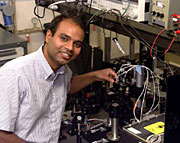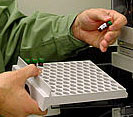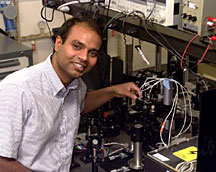| Research
|
|
||||||||||||||||||||||||||
|
Laser method could explain groundwater's odyssey The Sahara Desert was once a lush, green landscape dotted with lakes and ponds. Evidence of this past verdancy lies hidden beneath the sands of Egypt and Libya , in the form of a huge aquifer of fresh groundwater. An international team of geologists and physicists has found that this groundwater has been flowing slowly northward (at about the rate grass grows) for the past million years. Determining residence times and flow velocities of groundwater in aquifers is a vexing challenge. The extremely rare radioactive isotope krypton-81 (half-life of 229,000 years), which is produced by cosmic rays in the atmosphere, could be an ideal groundwater chronometer on the million-year time scale, but it has been nearly impossible to measure because of its low abundance. There is only one atom of krypton-81 in a trillion atoms of atmospheric krypton, a rare gas to begin with, and krypton is absorbed only slightly by water. Recently, scientists at DOE's Argonne have developed a laser-based method to count individual atoms of krypton-81 and measure its abundance accurately. Known as ATTA, for Atom-Trap Trace Analysis, this new, ultrasensitive method could revolutionize the scientific study of such topics as continental groundwater flow, long-term glacier motion, and seawater circulation through the ocean floor, say the researchers. The researchers, from Argonne , the University of Illinois at Chicago , State University of New York at Buffalo , and the University of Bern report the most extensive measurements yet made for krypton-81 in groundwater. In the first application of the ATTA method to a groundwater investigation, this team visited the Western Desert of Egypt to sample krypton from the Nubian Aquifer groundwater, which was reputedly old but of unknown age. To obtain a sufficient amount of krypton for the ATTA measurements, the team had to extract dissolved gases from thousands of liters of groundwater in the field, using a device invented by the Swiss members of the team. The gas extracted from each well was compressed into steel containers and shipped to Bern , where the trace amount of krypton in each sample was purified and delivered to Argonne for analysis of krypton-81. ATTA measured the ratios of krypton-81 to ordinary krypton, which ranged from about five to 53 percent of that in the air, corresponding to groundwater ages of 200,000 to 1,000,000 years. Based on these data, it is possible to estimate the direction and velocity of the groundwater flow, which is about one-to-two meters [yards] per year toward the north, and to determine the recharge location in southwest Egypt . This confirms results from some previous numerical hydrologic models, but refutes others. Isotopic characteristics of the water itself indicate that it was transported by air masses traveling long distances over North Africa from the Atlantic Ocean , thus reflecting climate conditions much different from the present during the past million years. Changing climate patterns turned this green oasis into today's desert. The research was funded primarily by the National Science Foundation and DOE.Submitted by DOE's Argonne National Laboratory |




